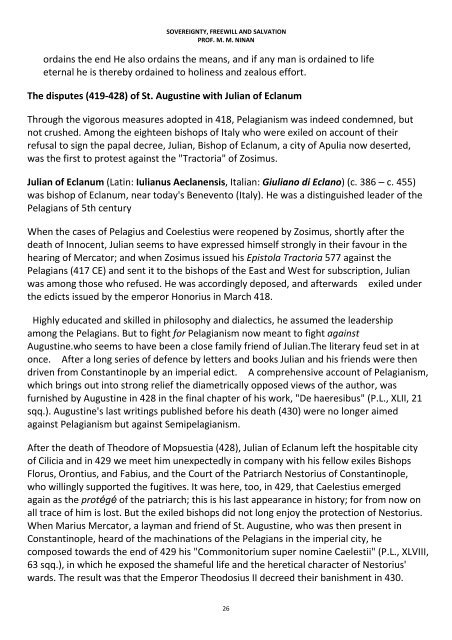Calvinism and Arminianism
You also want an ePaper? Increase the reach of your titles
YUMPU automatically turns print PDFs into web optimized ePapers that Google loves.
SOVEREIGNTY, FREEWILL AND SALVATION<br />
PROF. M. M. NINAN<br />
ordains the end He also ordains the means, <strong>and</strong> if any man is ordained to life<br />
eternal he is thereby ordained to holiness <strong>and</strong> zealous effort.<br />
The disputes (419-428) of St. Augustine with Julian of Eclanum<br />
Through the vigorous measures adopted in 418, Pelagianism was indeed condemned, but<br />
not crushed. Among the eighteen bishops of Italy who were exiled on account of their<br />
refusal to sign the papal decree, Julian, Bishop of Eclanum, a city of Apulia now deserted,<br />
was the first to protest against the "Tractoria" of Zosimus.<br />
Julian of Eclanum (Latin: Iulianus Aeclanensis, Italian: Giuliano di Eclano) (c. 386 – c. 455)<br />
was bishop of Eclanum, near today's Benevento (Italy). He was a distinguished leader of the<br />
Pelagians of 5th century<br />
When the cases of Pelagius <strong>and</strong> Coelestius were reopened by Zosimus, shortly after the<br />
death of Innocent, Julian seems to have expressed himself strongly in their favour in the<br />
hearing of Mercator; <strong>and</strong> when Zosimus issued his Epistola Tractoria 577 against the<br />
Pelagians (417 CE) <strong>and</strong> sent it to the bishops of the East <strong>and</strong> West for subscription, Julian<br />
was among those who refused. He was accordingly deposed, <strong>and</strong> afterwards exiled under<br />
the edicts issued by the emperor Honorius in March 418.<br />
Highly educated <strong>and</strong> skilled in philosophy <strong>and</strong> dialectics, he assumed the leadership<br />
among the Pelagians. But to fight for Pelagianism now meant to fight against<br />
Augustine.who seems to have been a close family friend of Julian.The literary feud set in at<br />
once. After a long series of defence by letters <strong>and</strong> books Julian <strong>and</strong> his friends were then<br />
driven from Constantinople by an imperial edict. A comprehensive account of Pelagianism,<br />
which brings out into strong relief the diametrically opposed views of the author, was<br />
furnished by Augustine in 428 in the final chapter of his work, "De haeresibus" (P.L., XLII, 21<br />
sqq.). Augustine's last writings published before his death (430) were no longer aimed<br />
against Pelagianism but against Semipelagianism.<br />
After the death of Theodore of Mopsuestia (428), Julian of Eclanum left the hospitable city<br />
of Cilicia <strong>and</strong> in 429 we meet him unexpectedly in company with his fellow exiles Bishops<br />
Florus, Orontius, <strong>and</strong> Fabius, <strong>and</strong> the Court of the Patriarch Nestorius of Constantinople,<br />
who willingly supported the fugitives. It was here, too, in 429, that Caelestius emerged<br />
again as the protégé of the patriarch; this is his last appearance in history; for from now on<br />
all trace of him is lost. But the exiled bishops did not long enjoy the protection of Nestorius.<br />
When Marius Mercator, a layman <strong>and</strong> friend of St. Augustine, who was then present in<br />
Constantinople, heard of the machinations of the Pelagians in the imperial city, he<br />
composed towards the end of 429 his "Commonitorium super nomine Caelestii" (P.L., XLVIII,<br />
63 sqq.), in which he exposed the shameful life <strong>and</strong> the heretical character of Nestorius'<br />
wards. The result was that the Emperor Theodosius II decreed their banishment in 430.<br />
26

















